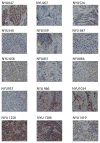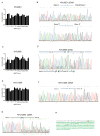High Incidence of Somatic BAP1 alterations in sporadic malignant mesothelioma
- PMID: 25658628
- PMCID: PMC4408084
- DOI: 10.1097/JTO.0000000000000471
High Incidence of Somatic BAP1 alterations in sporadic malignant mesothelioma
Abstract
Background: Breast cancer 1-associated protein 1 (BAP1) is a nuclear deubiquitinase that regulates gene expression, transcription, DNA repair, and more. Several findings underscore the apparent driver role of BAP1 in malignant mesothelioma (MM). However, the reported frequency of somatic BAP1 mutations in MM varies considerably, a discrepancy that appeared related to either methodological or ethnical differences across various studies.
Methods: To address this discrepancy, we carried out comprehensive genomic and immunohistochemical (IHC) analyses to detect somatic BAP1 gene alterations in 22 frozen MM biopsies from U.S. MM patients.
Results: By combining Sanger sequencing, multiplex ligation-dependent probe amplification, copy number analysis, and cDNA sequencing, we found alteration of BAP1 in 14 of 22 biopsies (63.6%). No changes in methylation were observed. IHC revealed normal nuclear BAP1 staining in the eight MM containing wild-type BAP1, whereas no nuclear staining was detected in the 14 MM biopsies containing tumor cells with mutated BAP1. Thus, IHC results were in agreement with those obtained by genomic analyses. We then extended IHC analysis to an independent cohort of 70 MM biopsies, of which there was insufficient material to perform molecular studies. IHC revealed loss of BAP1 nuclear staining in 47 of these 70 MM biopsies (67.1%).
Conclusions: Our findings conclusively establish BAP1 as the most commonly mutated gene in MM, regardless of ethnic background or other clinical characteristics. Our data point to IHC as the most accessible and reliable technique to detect BAP1 status in MM biopsies.
Conflict of interest statement
M. Carbone has pending patent applications on BAP1, and both Dr. Carbone and Dr. Gazdar provide consultation for mesothelioma expertise and diagnosis. The remaining authors declare no competing financial interests.
Figures





Comment in
-
Genetic Basis of Mesothelioma--More Than Asbestos Exposure.J Thorac Oncol. 2016 Feb;11(2):e27-8. doi: 10.1016/j.jtho.2015.09.005. Epub 2015 Dec 23. J Thorac Oncol. 2016. PMID: 26845122 No abstract available.
Similar articles
-
BAP1 Is Altered by Copy Number Loss, Mutation, and/or Loss of Protein Expression in More Than 70% of Malignant Peritoneal Mesotheliomas.J Thorac Oncol. 2017 Apr;12(4):724-733. doi: 10.1016/j.jtho.2016.12.019. Epub 2016 Dec 27. J Thorac Oncol. 2017. PMID: 28034829
-
BAP1 gene mutations in Egyptian patients with advanced sporadic malignant pleural mesothelioma (MPM): relation with clinical outcomes and survival.Cancer Genet. 2018 Dec;228-229:83-92. doi: 10.1016/j.cancergen.2018.10.001. Epub 2018 Oct 8. Cancer Genet. 2018. PMID: 30553477
-
Mesothelioma patient derived tumor xenografts with defined BAP1 mutations that mimic the molecular characteristics of human malignant mesothelioma.BMC Cancer. 2015 May 8;15:376. doi: 10.1186/s12885-015-1362-2. BMC Cancer. 2015. PMID: 25952750 Free PMC article.
-
[Malignant mesothelioma and constitutional BAP1 gene mutations].Rev Mal Respir. 2019 Feb;36(2):241-248. doi: 10.1016/j.rmr.2017.11.014. Epub 2019 Jan 24. Rev Mal Respir. 2019. PMID: 30686559 Review. French.
-
The significance of BAP1 and MTAP/CDKN2A expression in well-differentiated papillary mesothelial tumour: a series of 21 cases and a review of the literature.Pathology. 2024 Aug;56(5):662-670. doi: 10.1016/j.pathol.2024.02.016. Epub 2024 May 9. Pathology. 2024. PMID: 38789301 Review.
Cited by
-
BAP1: Not just a BRCA1-associated protein.Cancer Treat Rev. 2020 Nov;90:102091. doi: 10.1016/j.ctrv.2020.102091. Epub 2020 Aug 20. Cancer Treat Rev. 2020. PMID: 32877777 Free PMC article. Review.
-
Wedding of Molecular Alterations and Immune Checkpoint Blockade: Genomics as a Matchmaker.J Natl Cancer Inst. 2021 Nov 29;113(12):1634-1647. doi: 10.1093/jnci/djab067. J Natl Cancer Inst. 2021. PMID: 33823006 Free PMC article. Review.
-
Isolated BAP1 Genomic Alteration in Malignant Pleural Mesothelioma Predicts Distinct Immunogenicity with Implications for Immunotherapeutic Response.Cancers (Basel). 2022 Nov 16;14(22):5626. doi: 10.3390/cancers14225626. Cancers (Basel). 2022. PMID: 36428720 Free PMC article.
-
Clinical and molecular validation of BAP1, MTAP, P53, and Merlin immunohistochemistry in diagnosis of pleural mesothelioma.Mod Pathol. 2022 Oct;35(10):1383-1397. doi: 10.1038/s41379-022-01081-z. Epub 2022 Apr 22. Mod Pathol. 2022. PMID: 35459788 Free PMC article.
-
5-hmC loss is another useful tool in addition to BAP1 and MTAP immunostains to distinguish diffuse malignant peritoneal mesothelioma from reactive mesothelial hyperplasia in peritoneal cytology cell-blocks and biopsies.Virchows Arch. 2022 Jul;481(1):23-29. doi: 10.1007/s00428-022-03336-1. Epub 2022 May 16. Virchows Arch. 2022. PMID: 35575935
References
-
- Ismail-Khan R, Robinson LA, Williams CC, Jr, et al. Malignant pleural mesothelioma: a comprehensive review. Cancer Control. 2006;13:255–263. - PubMed
-
- Baumann F, Ambrosi JP, Carbone M. Asbestos is not just asbestos: an unrecognised health hazard. Lancet Oncology. 2013;14:576–578. - PubMed
-
- Roushdy-Hammady I, Siegel J, Emri S, et al. Genetic-susceptibility factor and malignant mesothelioma in the Cappadocian region of Turkey. Lancet. 2001;357:444–445. - PubMed
Publication types
MeSH terms
Substances
Grants and funding
LinkOut - more resources
Full Text Sources
Medical
Research Materials

